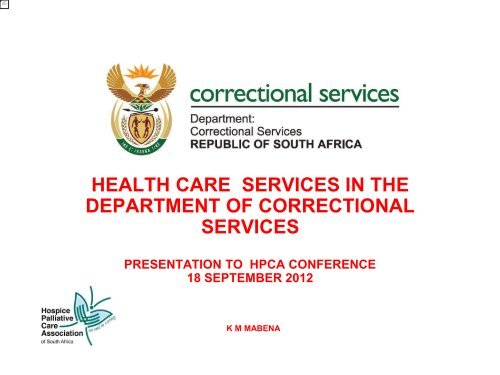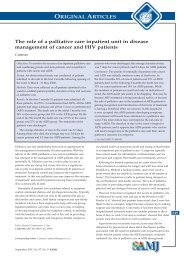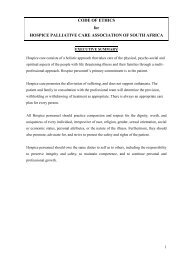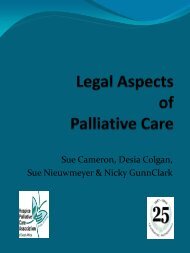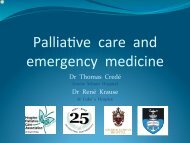DCS & HPCA – care in correctional services - Hospice Palliative ...
DCS & HPCA – care in correctional services - Hospice Palliative ...
DCS & HPCA – care in correctional services - Hospice Palliative ...
You also want an ePaper? Increase the reach of your titles
YUMPU automatically turns print PDFs into web optimized ePapers that Google loves.
HEALTH CARE SERVICES IN THE<br />
DEPARTMENT OF CORRECTIONAL<br />
SERVICES<br />
PRESENTATION TO <strong>HPCA</strong> CONFERENCE<br />
18 SEPTEMBER 2012<br />
K M MABENA
Confidential<br />
1. Introduction.<br />
2. Background<br />
3. The most prevalent diseases<br />
4. Functions of the Directorate<br />
5. <strong>Palliative</strong> <strong>care</strong> <strong>in</strong> <strong>DCS</strong><br />
6. Challenges<br />
7. Recommendations<br />
PRESENTATION OVERVIEW<br />
Document ref number<br />
1
Confidential<br />
INTRODUCTION<br />
� Incarcerated persons represent a small proportion of the total South<br />
African population, who are also at risk of develop<strong>in</strong>g health and social<br />
problems.<br />
� International norms and standards require that <strong>in</strong>mates must have<br />
access to the same quality and range of health <strong>care</strong> <strong>services</strong> as the<br />
general public receives from the National Health Services. A person’s<br />
capacity to access these <strong>services</strong> should not be compromised by<br />
reasons of <strong>in</strong>carceration s<strong>in</strong>ce all people have a basic right to health,<br />
nutrition, clean and safe environment as obligated by the Constitution of<br />
the Republic of South Africa..<br />
� In terms of the Correctional Services Act, (Act 111 of 1998), the<br />
department provides primary health <strong>care</strong> <strong>services</strong> and refer patients to<br />
external health <strong>care</strong> facilities for secondary and tertiary levels of health<br />
<strong>care</strong>.<br />
� The Department has been faced with a number of challenges with<br />
regard to the provision of primary health <strong>services</strong> to the <strong>in</strong>mates.<br />
Document ref number<br />
2
Confidential<br />
INTRODUCTION (Cont’)<br />
� A number of offenders and remand deta<strong>in</strong>ees suffer from various<br />
illnesses with poor prognosis which are progressive and non-reversible.<br />
� Some offenders suffer from medical conditions which are related to<br />
ag<strong>in</strong>g and are progressive <strong>in</strong> nature.<br />
� Only a small number of these offenders are considered for placement on<br />
medical grounds and released before they can die whilst others die <strong>in</strong><br />
custody.<br />
� Seriously ill offenders and remand deta<strong>in</strong>ees can be categorized <strong>in</strong>to<br />
those with:<br />
� a term<strong>in</strong>al illness with poor prognosis;<br />
� Alzheimer’s and related dementia; and<br />
� a serious, progressive and non-reversible illness with poor prognosis,<br />
which has profound functional and cognitive impairments.<br />
� On referral to external health facilities offenders and remand deta<strong>in</strong>ees<br />
are discharged with recommendations that palliative <strong>care</strong> must be<br />
provided.<br />
Document ref number<br />
3
BACKGROUND<br />
� The department is comprised of six Regions (Eastern Cape, Free<br />
State/Northern Cape, KwaZulu-Natal, Limpopo/Mpumalanga/North<br />
West), 48 Management Areas (similar to District) and 242 Correctional<br />
Centres (similar to PHC facility).<br />
� There is at least one Primary Health Care (PHC) cl<strong>in</strong>ic per Correctional<br />
Centre and one <strong>in</strong>-patient facility /sickbay with beds rang<strong>in</strong>g from 5-120.<br />
� An <strong>in</strong>-patient facility is def<strong>in</strong>ed as a facility that has been established <strong>in</strong> a<br />
Correctional Centre for the purpose of accommodat<strong>in</strong>g <strong>in</strong>mates that are<br />
either ill or recover<strong>in</strong>g from post-operative procedures and cannot be<br />
accommodated <strong>in</strong> the general cells whilst on treatment. The facility<br />
usually does not meet the requirements for be<strong>in</strong>g classified as a<br />
hospital.<br />
� Patients requir<strong>in</strong>g palliative <strong>care</strong> are admitted <strong>in</strong> these facilities.<br />
� The department recruits health <strong>care</strong> professionals (professional nurses,<br />
pharmacists, medical practitioners, psychologists), spiritual <strong>care</strong> workers<br />
and social workers as members of the multidiscipl<strong>in</strong>ary team.<br />
� The health facilities have not been fully <strong>in</strong>tegrated <strong>in</strong>to the District Health<br />
System.
160000<br />
140000<br />
120000<br />
100000<br />
80000<br />
60000<br />
40000<br />
20000<br />
0<br />
BACKGROUND<br />
Total <strong>in</strong>mate population end July 2012<br />
EC FS.NC GP KZN LMN WC TOTAL<br />
Males 17692 20170 35537 24717 20500 24144 142760<br />
Females 300 288 1138 471 301 777 3275<br />
TOTAL 17992 20458 36675 25188 20801 24921 146035<br />
Males<br />
Females<br />
TOTAL
1200<br />
1000<br />
800<br />
600<br />
400<br />
200<br />
0<br />
BACKGROUND<br />
Females <strong>in</strong>mates end July 2012<br />
EC FS.NC GP KZN LMN WC<br />
Females
5628<br />
BACKGROUND<br />
Remand deta<strong>in</strong>ees vs the sentenced population<br />
12064<br />
49<br />
251<br />
MALE FEMALE MALE FEMALE<br />
REMAND DETAINEES SENTENCED OFFENDERS
THE MOST COMMON PREVALENT CONDITIONS AMONGST<br />
OFFENDERS<br />
Respiratory tract <strong>in</strong>fections: TB,<br />
pneumonia, asthma and bronchitis<br />
Sexually transmitted <strong>in</strong>fections, HIV<br />
and AIDS<br />
Cardiovascular (Hypertension)<br />
Gastro Intest<strong>in</strong>al Tract Illnesses<br />
(haemorrhoids, ulcers, gastritis)<br />
Mental health conditions<br />
Cancer<br />
Seasonal viral <strong>in</strong>fections<br />
Musculoskeletal conditions<br />
Ear, nose and throat conditions<br />
Neurological (epilepsy)<br />
Dermatological<br />
Endocr<strong>in</strong>e (diabetes)
FUNCTIONS OF HEALTH CARE SERVICES IN THE<br />
DEPARTMENT<br />
COMPONENT CORE FUNCTION<br />
Primary Health<br />
Care<br />
Nutrition and<br />
Hygiene Services<br />
Pharmaceutical<br />
Services<br />
To facilitate the provision of Primary Health Care<br />
Services (<strong>in</strong>cludes disease prevention, health<br />
promotion, curative, rehabilitative and referral <strong>services</strong><br />
for secondary and tertiary <strong>services</strong>) .<br />
To facilitate the provision of basic food <strong>services</strong> <strong>in</strong> l<strong>in</strong>e<br />
with the applicable prescripts as well as personal and<br />
environmental hygiene <strong>services</strong> .<br />
To ensure implementation of the National Drug Policy<br />
and adequate supply of safe, cost effective drugs of<br />
acceptable quality and the rational use of medic<strong>in</strong>es by<br />
prescribers, dispensers and patients.
PALLIATIVE CARE IN <strong>DCS</strong><br />
� As the burden of diseases <strong>in</strong>creased, the need for palliative arouse<br />
<strong>in</strong> the Department.<br />
� This need was further <strong>in</strong>tensified after the Special Assignment<br />
documentary <strong>in</strong> 2008.<br />
� A relationship was established between <strong>DCS</strong> and <strong>HPCA</strong> <strong>in</strong> order to<br />
implement palliative <strong>care</strong> <strong>in</strong> <strong>DCS</strong>.<br />
� A recommendation was made and <strong>in</strong> consultation with KZN Region,<br />
decision was then taken to pilot palliative <strong>care</strong> there.<br />
� A plan was developed to address amongst others the follow<strong>in</strong>g:<br />
� Establishment of relationship with <strong>HPCA</strong>.<br />
� Approval by management of KZN Region.<br />
� Establishment of a multidiscipl<strong>in</strong>ary team.<br />
� Market<strong>in</strong>g of palliative <strong>care</strong> the officials, <strong>in</strong>mates and families.<br />
� Identification of pilot sites.<br />
� Resourc<strong>in</strong>g of the facilities.<br />
� Tra<strong>in</strong><strong>in</strong>g of the multidiscipl<strong>in</strong>ary team members and offenders (43 ).
SPECIFIC EQUIPMENT FOR PALLIATIVE CARE<br />
SPECIAL BED FOR A BED RIDDEN PATIENT IN DURBAN<br />
MED B.
A MIXED WARD IN DURBAN MED B FOR THE PROVISION<br />
OF PALLAITIVE CARE. CARE GIVER CLEANING THE<br />
WARD.
Some Of The Infrastructure Adaptations: Wall Mounted<br />
Central Oxygen Supply Po<strong>in</strong>ts <strong>in</strong> Durban Med B and Also A<br />
Mobile Unit For Backup
Mixed palliative <strong>care</strong> ward <strong>in</strong> Pietermaritzburg Med A (permanent<br />
Medical practitioner, patient and a Custodial Official
PALLIATIVE CARE IN <strong>DCS</strong><br />
� Order<strong>in</strong>g, storage and control of palliative <strong>care</strong> medic<strong>in</strong>es.<br />
� Conven<strong>in</strong>g of regular meet<strong>in</strong>gs to monitor progress and address<br />
challenges.<br />
� Development of record<strong>in</strong>g and report<strong>in</strong>g tools as well as system.<br />
� Review of visit<strong>in</strong>g policies to term<strong>in</strong>ally ill patients to allow for longer<br />
hours, contact visits, frequency, etc<br />
� Piloted successfully <strong>in</strong> Durban Westville and Pietermaritzburg.<br />
� SLA signed between KZN Region and <strong>HPCA</strong> <strong>in</strong> October 2009.<br />
Role and support of <strong>HPCA</strong>:<br />
� Facilitation of tra<strong>in</strong><strong>in</strong>g,<br />
� Mentor<strong>in</strong>g.<br />
� Establishment of referral systems.<br />
� Ward rounds (Durban).<br />
� Establishment of records systems.
SIGNING OF THE SLA IN 2009 IN DURBAN: US EMBASSY REP,<br />
ACT DEPUTY REGIONAL COMMISSIONER, CEO OF <strong>HPCA</strong><br />
AND DIR HEALTH
A medical practitioner car<strong>in</strong>g for a patient
PALLIATIVE CARE IN <strong>DCS</strong><br />
� A national Memorandum of Understand<strong>in</strong>g has been approved and<br />
signed by the National Commissioner and the CEO of <strong>HPCA</strong> <strong>in</strong> May<br />
2012.<br />
� A need was identified to roll out palliative <strong>care</strong> start<strong>in</strong>g <strong>in</strong> 2<br />
Management Areas per Region.<br />
� <strong>HPCA</strong> has sought fund<strong>in</strong>g to cont<strong>in</strong>ue support<strong>in</strong>g the <strong>DCS</strong> <strong>in</strong> the<br />
implementation of palliative <strong>care</strong>.<br />
� These Management Areas are at different levels of preparation.<br />
� A number of professional nurses are currently attend<strong>in</strong>g tra<strong>in</strong><strong>in</strong>g on<br />
palliative <strong>care</strong>.<br />
� Spiritual Care has become part of the of multidiscipl<strong>in</strong>ary team <strong>in</strong> the<br />
provision of palliative <strong>care</strong> to the <strong>in</strong>mates <strong>in</strong> <strong>DCS</strong> and the chapla<strong>in</strong>s<br />
had a tra<strong>in</strong><strong>in</strong>g workshop on bereavement counsell<strong>in</strong>g.<br />
� <strong>HPCA</strong> has facilitated a session for the draft<strong>in</strong>g of Guidel<strong>in</strong>es on the<br />
Provision of <strong>Palliative</strong> Care <strong>in</strong> Correctional Services.
DR. LIZ GWYTHER HANDING OUT CERTIFICATES TO<br />
OFFENDERS WHO COMPLETED PALLIATIVE CARE TRAINING<br />
2011
BENEFITS OF PALLIATIVE CARE IN <strong>DCS</strong><br />
• <strong>Palliative</strong> <strong>care</strong> ma<strong>in</strong>ta<strong>in</strong>s quality of life by address<strong>in</strong>g physical<br />
symptoms such as pa<strong>in</strong> or nausea as well as help<strong>in</strong>g with emotional,<br />
spiritual and social needs of the term<strong>in</strong>ally ill.<br />
• The <strong>in</strong>mate population becomes more <strong>in</strong>formed on palliative <strong>care</strong>.<br />
• Improved confidence amongst health <strong>care</strong> providers.<br />
• Provision of a higher quality of comprehensive health <strong>care</strong> to the<br />
<strong>in</strong>mate patient population.<br />
• Strengthen<strong>in</strong>g relationships amongst the patients and their families<br />
as well as the multidiscipl<strong>in</strong>ary team members.
PALLIATIVE CARE AND MEDICAL PAROLE<br />
• Correctional Matters Amendment Act- May 2012.<br />
• Regulations <strong>–</strong> February 2012.<br />
• Policy and procedures - February 2012.<br />
• Launch of Medical Parole Advisory Board.<br />
• Criteria:<br />
� Chronic disease, progressive, irreversible and term<strong>in</strong>al.<br />
� Medical conditions (<strong>in</strong>fectious and non-<strong>in</strong>fectious)<br />
• A number of patients recommended for medical parole and<br />
released.<br />
• Those without external support (reluctance by families and lost<br />
contact with friend and families) kept <strong>in</strong> Correctional facilities and<br />
provided with palliative <strong>care</strong>.
Confidential<br />
Health facilities:<br />
� The designs of Correctional Centres were focused on security and<br />
do not complement health <strong>care</strong> delivery for patients, result<strong>in</strong>g <strong>in</strong><br />
<strong>in</strong>adequate primary health <strong>care</strong> cl<strong>in</strong>ics and <strong>in</strong>-patient facilities that<br />
are not up to standard regard<strong>in</strong>g the equipment, <strong>in</strong>-patient facilities<br />
and isolation cells. In some areas, cells and offices have been<br />
converted <strong>in</strong>to primary health <strong>care</strong> cl<strong>in</strong>ics.<br />
Attitudes:<br />
CHALLENGES<br />
There was “Fear of the unknown” and resistance to change.<br />
Document ref number<br />
22
Confidential<br />
Human resources:<br />
CHALLENGES (Cont’)<br />
� The <strong>in</strong>ability to recruit and reta<strong>in</strong> health <strong>care</strong> professionals<br />
(professional nurses, medical practitioners, pharmacists and<br />
psychologists),<br />
� Lack of a structure for other categories of health <strong>care</strong> professionals<br />
(dietitians, enrolled nurs<strong>in</strong>g assistants, nurs<strong>in</strong>g assistants,<br />
pharmacist assistants, emergency medical <strong>services</strong> etc).<br />
� Lack of mechanisms to address tra<strong>in</strong><strong>in</strong>g needs for emerg<strong>in</strong>g<br />
diseases, patients’ needs such as palliative <strong>care</strong> and new treatment<br />
guidel<strong>in</strong>es; hence the Department is dependent on over-stretched<br />
Districts.<br />
Lack of supplies and other pharmaceuticals<br />
� Lack of adequate and access to pa<strong>in</strong> medication when required.<br />
Document ref number<br />
23
CATEGORY TOTAL NO.<br />
Prof nurses 820<br />
Medical<br />
practitioners<br />
8<br />
Pharmacists 21<br />
Community<br />
Service<br />
Pharmacists<br />
13<br />
Psychologists 16<br />
Spiritual Care<br />
Workers<br />
1427<br />
Social Workers 650<br />
HUMAN RESOURCE CAPACITY
Confidential<br />
IMPACT OF INADEQUATE RESOURCES<br />
� Limited or <strong>in</strong>adequate management of diseases which may lead to<br />
complications and deaths.<br />
� Increased spread of communicable diseases and deaths due to lack of<br />
adequate prevention, health promotion and timeous curative <strong>care</strong>.<br />
� Increased referrals to external health <strong>care</strong> providers even for <strong>in</strong>fections<br />
that could be treated at primary health <strong>care</strong> level result<strong>in</strong>g <strong>in</strong> <strong>in</strong>creased<br />
health <strong>care</strong> costs and security risks.<br />
� Limited or <strong>in</strong>adequate provision of palliative <strong>care</strong> which leads to more<br />
suffer<strong>in</strong>g by the patients.<br />
� Limited access to medical <strong>services</strong> result<strong>in</strong>g <strong>in</strong> delays on some<br />
<strong>in</strong>terventions, e.g. prescription of pa<strong>in</strong> medication.<br />
� Management Areas without access to departmental pharmacies utilize<br />
retail pharmacies for the procurement of medication and the costs are<br />
higher than the public tender prices and delays <strong>in</strong> provid<strong>in</strong>g pa<strong>in</strong><br />
medication to the patients.<br />
Document ref number<br />
25
RECOMMENDATIONS<br />
• Need for management leadership and commitment for palliative<br />
to be a success. All role players to cont<strong>in</strong>ue advocat<strong>in</strong>g for palliative<br />
<strong>care</strong> <strong>in</strong> Correctional environments.<br />
• Evidence-based practice: policies and programmes must be<br />
reviewed and/or developed based upon established need, on<br />
empirical evidence of effectiveness, and evaluated models of<br />
palliative <strong>care</strong> best practices<br />
• Health standards and cont<strong>in</strong>uity of <strong>care</strong> and treatment: the<br />
department must ensure that it meets <strong>in</strong>ternational obligations to<br />
provide health <strong>care</strong> which is equivalent to that available to the<br />
outside population, and to ensure cont<strong>in</strong>uity of <strong>care</strong> and not let<br />
<strong>in</strong>mates suffer.<br />
• Conditions: they must not violate the <strong>in</strong>mates rights to dignity.<br />
• Tra<strong>in</strong><strong>in</strong>g and support : all relevant professionals must be provided<br />
with the knowledge, tra<strong>in</strong><strong>in</strong>g, and support on palliative <strong>care</strong><br />
necessary to meet the requirements and responsibilities of their<br />
work.
RECOMMENDATIONS (Cont’)<br />
• International, national, and regional collaboration: South Africa<br />
and <strong>HPCA</strong> to share knowledge and expertise on effective palliative<br />
<strong>care</strong> with<strong>in</strong> the Correctional environment both nationally and<br />
<strong>in</strong>ternationally and to enhance the development of evidence-based<br />
practices <strong>in</strong> this area.<br />
• Fund<strong>in</strong>g and resources: The Department to develop and<br />
implement national fund<strong>in</strong>g plans to address palliative <strong>care</strong> at<br />
national, regional, and local levels.
Confidential<br />
CONCLUSION<br />
With the assistance and collaboration ALL RELEVANT STAKEHOLDERS,<br />
the Department rema<strong>in</strong>s committed <strong>in</strong> improv<strong>in</strong>g health <strong>care</strong> <strong>services</strong><br />
rendered to those entrusted to its <strong>care</strong> despite the numerous challenges it is<br />
faced with.<br />
Document ref number<br />
28
Thank you


